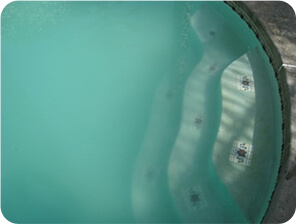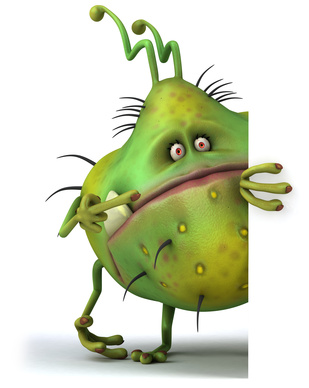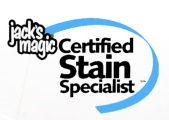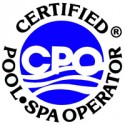Archive for Algae
What Is Algae?
Posted by: | CommentsAlgae is the most common fouler of pools. When pool owners panic and run screaming to a pool pro for help, algae is most frequently the cause. That’s why we call it one of the best salesmen. You must deal with an algaecide. Actually, in addition to getting rid of algae, one of the most effective uses of algaecide is to extend the effectiveness of chlorine residual. While chlorine is an algaecide, it’s wise to add additional quantities as a backup, a maintenance dose.
What is algae?
Algae are small plants Read More→
Preventing Cloudy Pool Water
Posted by: | CommentsHow to prevent and eliminate cloudy water
 As bather loads peak in the summer heat, it is that time of the year again when sparkling clear water can become clouded and unsanitary. What is a pool operator to do? Cloudy water is an indication that the disinfection and filtration systems are not keeping up with the load being placed on them by the number of bathers using the pool. Cloudy water is not just unappealing to the bather. It can also be a health hazard by inducing potential spread of illnesses and decreasing the lifeguards’ ability to see submerged drowning victims. There are many reasons water can become cloudy. Let’s break down the causes, then review the remedies of unsightly and potentially hazardous water. Read More→
As bather loads peak in the summer heat, it is that time of the year again when sparkling clear water can become clouded and unsanitary. What is a pool operator to do? Cloudy water is an indication that the disinfection and filtration systems are not keeping up with the load being placed on them by the number of bathers using the pool. Cloudy water is not just unappealing to the bather. It can also be a health hazard by inducing potential spread of illnesses and decreasing the lifeguards’ ability to see submerged drowning victims. There are many reasons water can become cloudy. Let’s break down the causes, then review the remedies of unsightly and potentially hazardous water. Read More→
What Causes Algae?
Posted by: | CommentsAlgae spores are everywhere. These microscopic single-cell structures are blown into the pool by the wind, washed into the pool by rainfall, or carried into the pool on swimmers’ skin or bathing suits.  Under the right conditions, tiny spores will bloom into those dreaded bright green, mustard yellow or black discolorations.
Under the right conditions, tiny spores will bloom into those dreaded bright green, mustard yellow or black discolorations.
Inadequate filtration will often lead to algae growth.
Water clarity depends on daily circulation and filtration. Anything that impedes water flow from the pool to the filter — clogged skimmer baskets, a dirty or damaged filter, a defective pump motor, or a failure to run the pump for an adequate amount of time each day — will encourage algae growth. The first warning sign of a filtration problem is hazy or cloudy water. Left unchecked, cloudy water can quickly lead to a full-fledged algae bloom.
Algae can develop when little or no chlorine is present.
Sunlight, rainfall, temperature, number of swimmers and frequency of pool use affect the rate of chlorine loss. The lower the chlorine level, the more likely algae will bloom. Super-chlorination, coupled with the application of conditioner or stabilizer designed to shield residual chlorine from the effects of heat and sunlight, helps ensure that there is always sufficient chlorine in the pool. Spas, which are often heated to temperatures well above 100 degrees, are especially susceptible to algae growth.
Algae loves a dirty pool!
Leaves and dirt left on the bottom of the pool for an extended period of time, not only promotes algae but also causes pool staining. The longer you allow leaves and other debris to sit on your pool floor, the more likely that you’ll see algae, and staining. In a dirty pool, algae will continue to bloom, even when the water chemistry is properly balanced.
What Kind Of Algae Are You Growing
Posted by: | CommentsPool and hot tub water need to be properly sanitized in order to prevent the growth of algae. Algae will grow and thrive in well lit, shallow warm water that isn’t properly sanitized. The algae feed on sunlight and the minerals in the water. The waste products released from algae then become food for dangerous bacteria and germs.
To prevent algae from growing within your pool water, you’ll need to keep it properly sanitized. If you fail to sanitize your water on a regular basis, there’s a good chance algae will start to grow in the shallower areas of the pool that receive the highest amount of sunlight throughout the day. However, sometimes even the most well kept pools and spas will become subject to the growth of algae.
There are three types of algae that are most common for home owners: yellow algae, black algae, and green algae. Read More→
Black Algae in Pools
Posted by: | CommentsBlack algae in pool water can be one of the toughest types of algae to get rid of. This is because unless you kill it at its root, it will sprout new heads and continue to grow. Today we’re going to look at how to finally eliminate black algae and make sure it doesn’t return.
Unfortunately, black algae can grow even if sanitizer levels are within their best range, because of the protective layer each head has which prevents chemicals from entering its pores. It will appear as black, or blueish/green, and generally more common in plaster or concrete pools.
If you’re absolutely sure that you have black algae then here some steps you can take. Read More→
Why Does Algae Grow In My Pool?
Posted by: | CommentsAlgae – Those tiny plants that range in color from green to brown to yellow to red…and the scourge of them all…black. Black Algae? Oh, yes. Except that they are really a blue-green color.
Algae are unsightly and a nuisance. Although they are not themselves pathogenic, they can nevertheless be dangerous.  Algae are often covered with a slime layer which is slippery. and they can be a hiding place for bacteria.
Algae are often covered with a slime layer which is slippery. and they can be a hiding place for bacteria.
Under a microscope algae resemble a tiny apartment complex. Like most plants they flourish by consuming nutrients in the water (things like perspiration, urine and other swimmer waste). They also need plenty of sunlight to carry out photosynthesis. Most types of algae won’t grow in the dark…which is why you usually find algae growing on the sunny side of the pool.
Some forms of algae actually can ingest calcium, which they can find in the water or in the walls of a plastered pool.
And then there are the kinds that float in the water. And kinds that cling to the pool’[s interior surface.
Of the more than 21,000 types of algae, only about 40 to 50 inhabit swimming pools.
No, we don’t kill all the algae. Or bacteria either. We merely control them with chlorine, for one. And with algaecides. Algae spores are just waiting for a chance to get with the program. Let your guard down, and watch them grow. Rain, dust, wind and not telling what else bring algae spores into the pool water 24 hours a day. You’ve got to be ready for them.











